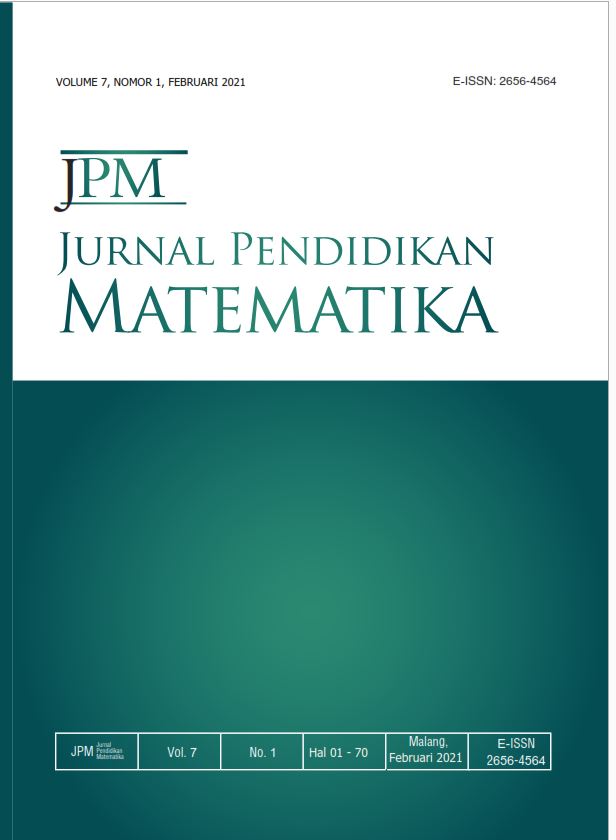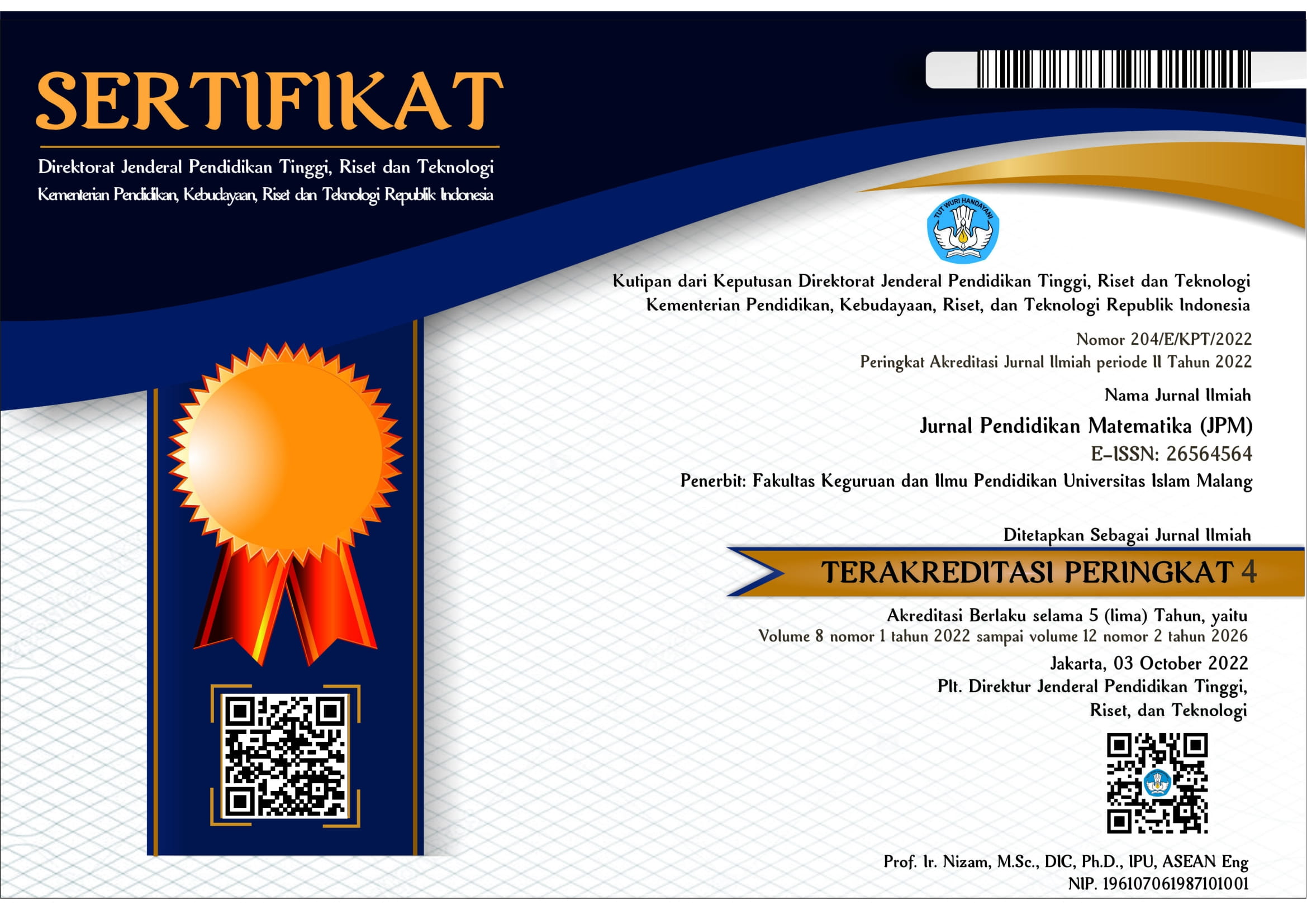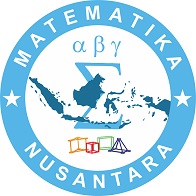Respon Mahasiswa Terhadap Penyelesaian Soal Koneksi Matematis Melalui Taksonomi Fink
DOI:
https://doi.org/10.33474/jpm.v7i1.8973Keywords:
Student Response, Fink Taxonomy, & Mathematical ConnectionsAbstract
Student response is an important aspect of learning because it helps educators understand student development. One of the frameworks used to analyze student responses to cognitive, affective, and metacognitive aspects is the Fink taxonomy. This study aims to find patterns of student response rates in solving mathematical connection through Fink's taxonomy. This research method is qualitative. The data collected were data on the ability of mathematical connections to measure student responses to cognitive and metacognitive aspects taken using test instruments as well as data on social and caring dimensions to measure student responses to affective aspects that were taken using questionnaires. The results of this study are student responses at the basic knowledge level of 18.42%, application of 12.79%, integration of 12.22%, social dimensions 23.28%, caring aspects of 22.34%, and metacognitive 10.95. % and student response results at the level of basic knowledge of 18.94%, application of 13.16%, integration of 11.23%, social dimensions 23.87%, caring aspects of 22.78%, and metacognitive of 10.02%. Student responses to cognitive, affective, and metacognitive aspects provide an overview for educators to pay attention to students' abilities and attitudes in building knowledge independently on a subject matter.
References
Chaplin, J. P. (2004). Kamus Lengkap Psikologi,(Terjemahan Kartini dan Kartono). Jakarta: Raja Grafindo Persada.
Ekawati, R., Junaedi, I., & Nugroho, S. E. (2013). Studi respon siswa dalam menyelesaikan soal pemecahan masalah matematika berdasarkan taksonomi SOLO. Unnes Journal of Mathematics Education Research, 2(2).
Eisenberg, N., & Fabes, R. A. (1990). Empathy: Conceptualization, measurement, and relation to prosocial behavior. Motivation and Emotion, 14(2), 131-149.
Fink, L. D. (2013). Creating significant learning experiences: An integrated approach to designing college courses. John Wiley & Sons.
Hamalik, O. (2011). Proses belajar mengajar. Jakarta: Bumi Aksara.
Hudojo, H. (1988). Mengajar belajar matematika. Jakarta: Depdikbud.
Latifah, I. U. (2017). Pengembangan instrumen penilaian hasil belajar Matematika berbasis Taksonomi Fink (Doctoral dissertation, UIN Sunan Ampel Surabaya).
Linto, R. L. (2012). Kemampuan koneksi matematis dan metode pembelajaran quantum teaching dengan peta pikiran. Jurnal Pendidikan Matematika, 1(1).
Pai’pinan, M. (2015). Profıl Metakognisi Mahasiswa Calon Guru Matematıka dalam Menyelesaıkan Masalah Terbuka Geometrı Ditinjau dari Perbedaan Gender. Jurnal Ilmıah Matematıka dan Pembelajarannya, 1(1).
Prawitasari, J. E., & Kahn, M. W. (1985). Personality differences and sex similarities in American and Indonesian college students. The Journal of Social Psychology, 124, 703-708.
Ramdani, Y. (2012). Pengembangan instrumen dan bahan ajar untuk meningkatkan kemampuan komunikasi, penalaran, dan koneksi matematis dalam konsep integral. Jurnal Penelitian Pendidikan, 13(1), 44-52.
Rhee, S. H., Boeldt, D. L., Friedman, N. P., Corley, R. P., Hewitt, J. K., Young, S. E., ... & Zahn-Waxler, C. (2013). The role of language in concern and disregard for others in the first years of life. Developmental Psychology, 49(2), 197.
Simanjuntak, S. D., & Imelda, I. (2018). Respon Siswa terhadap Pembelajaran Matematika Realistik dengan Konteks Budaya Batak Toba. MES: Journal of Mathematics Education and Science, 4(1), 81-88.
Suryadi, D. (2011). Kesetaraan Didactical Design Research (DDR) Dengan Matematika Realistik Dalam Pengembangan Pembelajaran Matematika. Jurnal FMIPA UPI Bandung.
Triyadi, R. (2013). Kemampuan matematis ditinjau dari perbedaan gender (Doctoral dissertation, Universitas Pendidikan Indonesia).
Wagner, T. (2012). Creating innovators: The making of young people who will change the world. Simon and Schuster.
Umaroh, U., & Pujiastuti, H. (2020). Analisis Kemampuan Representasi Matematis Siswa dalam Mengerjakan Soal PISA Ditinjau dari Perbedaan Gender. Jurnal Pendidikan Matematika Raflesia, 5(2), 40-53.
Wijaya, A. (2012). Pendidikan matematika realistik suatu alternatif pendekatan pembelajaran matematika. Yogyakarta: Graha Ilmu.






_-_Copy.jpg)
.jpg)
.jpg)










